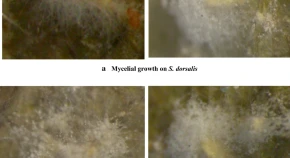Influence of spraying techniques on the efficacy of Beauveria bassiana-based mycoinsecticide against chilli and tomato thrips
Research Articles | Published: 30 March, 2020
First Page: 345
Last Page: 351
Views: 4102
Keywords: Scirtothrips dorsalis , Thrips tabaci , Beauveria bassiana , Delivery equipment
Abstract
Use of fungal entomopathogens can be an alternative to insecticides and could help in bio-intensive pest management. Entomopathogenic fungi may be used for chilli thrips, Scirtothrips dorsalis Hood and tomato thrips, Thrips tabaci Lindeman control. Field experiments were conducted with an oil formulation of Beauveria bassiana (Balsamo) Vuillemin fungal isolate @ 108 spores·mL−1 against chilli and tomato thrips. Several delivery systems were tested. Two field experiments conducted on chilli indicated that the Bb 112 oil-based formulation applied with a Controlled Droplet Applicator (CDA) sprayer produced the highest reduction of 54.12% and 48.82% thrips, respectively. For tomato thrips, the field trials indicated that Bb 112 oil formulation applied with CDA sprayer was significantly higher than the other treatments with 55.07% and 52.36% reduction, respectively. Therefore, one can notice that the synergism of the association between fungus and oil indicate its potential against the target pest in the field.

References
- Arthurs SP, Aristizabal LF, Avery PB (2013) Evaluation of entomopathogenic fungi against chilli thrips, Scirtothripsdorsalis. J Insect Sci 13:31 (abs.)
- Bateman RP (1997) Methods of application of microbial pesticide formulations for the control ofgrasshoppers and locusts. Mem Entomol Soc Can 171:67–79
- Bateman RP, Alves RT (2000) Delivery systems for mycoinsecticides using oil-based formulations. Asp Appl Biol 57:163–170
- Bateman RP, Carey M, Moore D, Prior C (1993) The enhanced infectivity of Metarhizium flavoviride in oil formulations to desert locusts at low humidities. Ann Appl Biol 122(1):145–152
- Brewster JL (1994) Onions and other vegetable alliums. CAB International, Wallingford
- Gatarayiha MC, Laing MD, Miller RM (2012) Field evaluation of Beauveria bassiana efficacy for the control of Tetranychus urticae Koch (Acari: Tetranychidae). J Appl Entomol 135(8):582–592
- Hajek AE, Ledger RJ (1994) Interaction between fungal pathogens and insect hosts. Annu Rev Entomol 39:293–322
- Legutowska H (1997) The occurrence of onion thrips on leeks plants. Prog Plt Protect 37:51–60
- Lewis T (1997) Pest thrips in perspective. In: Thrips as crop pests. CAB International, Wallingford
- Luz C, Fargues J (1997) Temperature and moisture requirements for conidial germination of an isolate of Beauveria bassiana, pathogenic to Rhodnius prolixus. Mycopathologia 138:117–125
- Parker BL, Skinner M, Lewis T (1995) Thrips biology and management. Plenum Press, New York
- Richter E, Hommes M, Krauthausen JH (1999) Investigations on the supervised control of Thrips tabaci in leek and onion crops. IOBC Bull 22(5):61–72
- Saranya S, Ushakumari R, Jacob S, Babu MP (2010) Efficacy of different entomopathogenic fungi against cowpea aphid, Aphis craccivora (Koch). J Bio Pestic 3(1):138–142
- Theunissen J, Legutowska H (1991) Thrips tabaci Lindeman (Thysanoptera, Thripidae) in leek within plant distribution. J Appl Entomol 112:309–316
Author Information
Karunya Institute of Technology and Sciences, Coimbatore, India